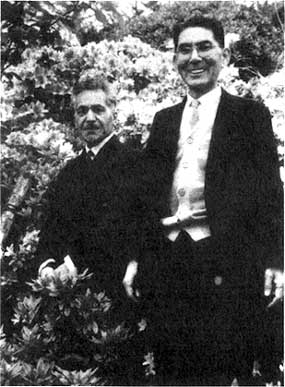
|
Traces That Remain:
A Pictorial History of the Early Days of the Bahá'í Faith among the Japanese
by Barbara R. Sims
edited by Sheridan Sims  |
chapter 62 | start page | single page | chapter 64 |  |
Chapter 63
In the Guardian's message to the first National Convention of the Bahá'ís of North East Asia (1957), and again in a later message, he emphasized that the Faith must be taken to the other smaller islands of Japan. Hand of the Cause Mr. Khazeh, who met with the newly formed national spiritual assembly suggested that someone settle in Kyushu as well as other islands.
Actually there was a Bahá'í already living in Kyushu, in Miyazaki Prefecture, Mr. Takeo Hasegawa. He had become a Bahá'í while in the United States, where he had gone to study in the early 1950s. He tells this story: He and another Japanese student were at a university in Texas. One day while they were walking on campus, a friendly elderly woman approached them.

June 1957, Mr. Katirai, middle, and Dr. Mottahedin, right, are about to leave Mr. Labib in Nagasaki. They stayed three days to help him get settled, during which there was a typhoon.
Mr. Hasegawa returned to Japan and had attended the Nikko Conference in 1955, but Miyazaki Prefecture was far away and he was not seen again for many years.
Mr. Muhammad Labib was living with Mr. and Mrs.

Mr. Muhammad Labib, the first pioneer to settle in Kyushu, with Mr. Shigeo Hario, who was the first to accept the Faith (1958) in Kyushu. This photograph was taken about 1959.
Many years later Mr. Katirai recalls the trip. "When we reached Nagasaki a typhoon was beginning. It had been a long trip and the three of us were quite dirty, because the train was coal-burning, no diesel trains there yet. At first, we couldn't find any place to go to clean up. To add to the problems Mr. Labib had an infection in his toe. His foot had swelled so much that he could not walk and he needed to have it attended to. I carried him on my back to a hospital we were directed to.
"When we entered the hospital, we saw the staff sitting at

click here for larger image
The first Bahá'í wedding in Kyushu was the marriage of Miss Akiko Enokida and Mr. Eugene Schreiber in Nagasaki in 1959. Mr. Labib is standing at the far right.
It was difficult for many pioneers in those days, both Americans and Persians, and especially for those with limited finances.
Mr. Labib was elderly, alone, knowing no Japanese, with barely enough funds. His situation was similar to that of Mr. Tehrani, the first to pioneer that same year to the northern island of Hokkaido.
Mr. Shigeo Hario, the first Japanese to become a Bahá'í in Kyushu, told the story of his friendship with Mr. Labib. It was late 1957 or early 1958. Mr. Hario was retired, but teaching part-time in a high school. He was also studying Japanese dance. One of the men in the dance class said a foreigner was renting a room at his house but he didn't know why. Perhaps the foreigner was a spy. Mr. Hario could speak fluent English so the man asked him to come and meet the foreigner.
Mr. Labib, vital and dedicated, had come to Nagasaki just a few months before. When the two men met it was the beginning of a close friendship. Together they did much service for the Faith. Mr. Hario said Mr. Labib came to his house almost every day, and they often went out meeting people, Mr. Labib talking and Mr. Hario translating. They sometimes went to schools where Mr. Labib would offer to speak on a variety of subjects, introducing the Faith, and making friends.
Mr. Hario was a Buddhist and came from a high-class samurai family. He read many Bahá'í books in both English and Japanese before he became a Bahá'í, but, he said, what originally attracted him to the Faith was Mr. Labib and his life.
Mr. Labib wanted to have a Bahá'í Center for Nagasaki so he could have more regular meetings. He and Mr. Hario searched for the land and had the Center built a couple of years later. A young American Bahá'í, Mr. Eugene Schreiber, an engineer who was working on an island nearby, generously contributed the money. Mr. Schreiber's marriage to Miss Akiko Enokida in 1959 was the first Bahá'í wedding in Kyushu.
Mr. and Mrs. Schreiber recall Mr. Labib and Mr. Hario with great affection. They said Mr. Labib made all the wedding arrangements and invited the people. Mr. Hario performed a traditional dance for the wedding guests.
 |
chapter 62 | start page | single page | chapter 64 |  |
|
|